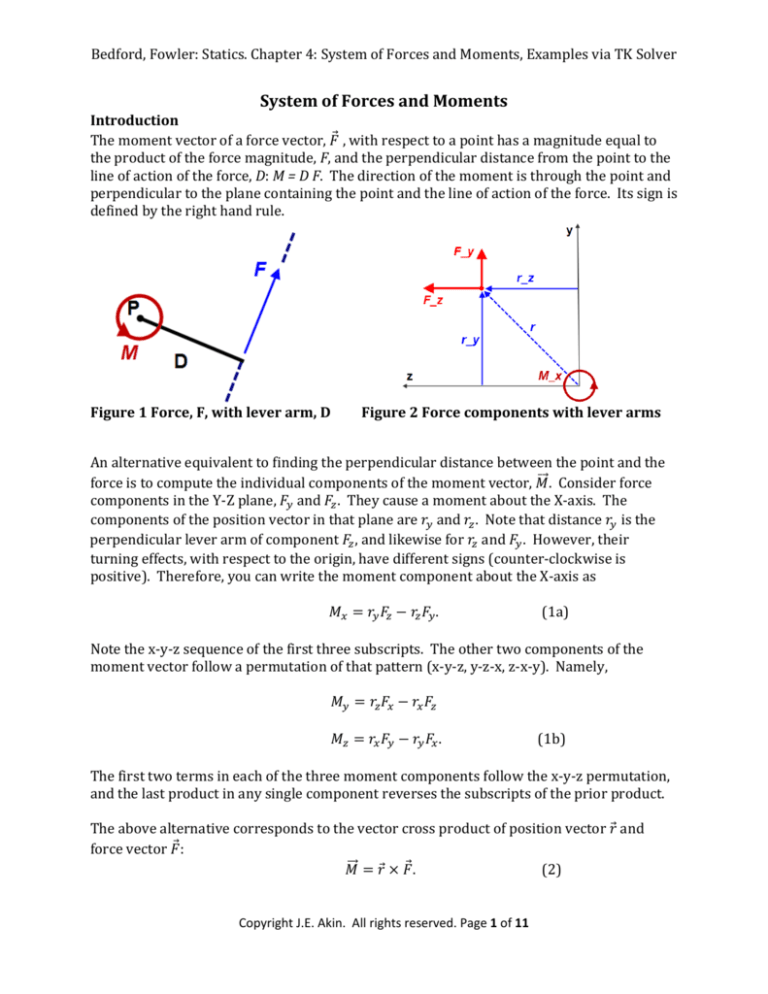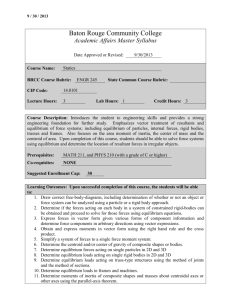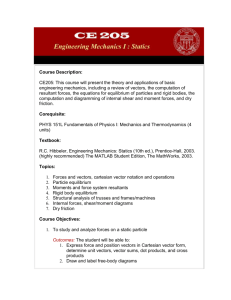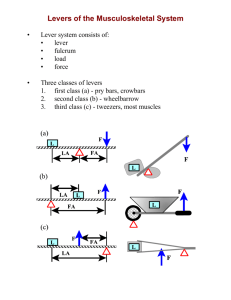
Bedford, Fowler: Statics. Chapter 4: System of Forces and Moments, Examples via TK Solver System of Forces and Moments Introduction The moment vector of a force vector, , with respect to a point has a magnitude equal to the product of the force magnitude, F, and the perpendicular distance from the point to the line of action of the force, D: M = D F. The direction of the moment is through the point and perpendicular to the plane containing the point and the line of action of the force. Its sign is defined by the right hand rule. Figure 1 Force, F, with lever arm, D Figure 2 Force components with lever arms An alternative equivalent to finding the perpendicular distance between the point and the force is to compute the individual components of the moment vector, . Consider force components in the Y‐Z plane, and . They cause a moment about the X‐axis. The components of the position vector in that plane are and . Note that distance is the perpendicular lever arm of component , and likewise for and . However, their turning effects, with respect to the origin, have different signs (counter‐clockwise is positive). Therefore, you can write the moment component about the X‐axis as . (1a) Note the x‐y‐z sequence of the first three subscripts. The other two components of the moment vector follow a permutation of that pattern (x‐y‐z, y‐z‐x, z‐x‐y). Namely, . (1b) The first two terms in each of the three moment components follow the x‐y‐z permutation, and the last product in any single component reverses the subscripts of the prior product. The above alternative corresponds to the vector cross product of position vector and force vector : . (2) Copyright J.E. Akin. All rights reserved. Page 1 of 11 Bedford, Fowler: Statics. Chapter 4: System of Forces and Moments, Examples via TK Solver The above component sequence permutation applies to any cross product of two vectors: (3) This form of the moment component calculations is easily entered into TK Solver. This component form is used in the presented examples below. In addition to finding the moment of a force at a point, you frequently need to find the portion of that moment that acts on a line through the point. That portion is called the moment of a force about a line. The magnitude of the moment about the line is the perpendicular projection of the total moment magnitude onto the line. That action is shown in Figure 3. In other words, it is the dot product of the moment vector and the unit vector that defines the direction cosines of the line: , (4) and the full vector moment about the line (including its components signs) is . (5) Figure 3 Projecting a moment vector onto a line In general, Newton’s static equilibrium relations involve both forces and moments. Specifically, the resultant force must vanish, as must the resultant moment about any arbitrary point, say P: ∑
0, ∑ 0. Almost all of the future applications will involve the use of moment equilibrium. Frequently, the choice of the location of the moment point, P, is taken at a point on the line of action of the force with the most unknown components. Since the lever arm to such forces is zero, those force vector components do not appear in the equations for the moment vector components. You can write valid moment equations at different points. With TK Solver, it is actually useful to have additional valid equations in the rule set. In the past, students were required Copyright J.E. Akin. All rights reserved. Page 2 of 11 Bedford, Fowler: Statics. Chapter 4: System of Forces and Moments, Examples via TK Solver to solve many different applications to learn by experience how to pick points that introduce the minimum number of unknowns into the moment equilibrium. Using TK Solver, you just need to count the number of unknowns and write at least that many valid equilibrium rules by using various FBD’s and/or by selecting various points for calculating the resultant moments. In this chapter, you learn how to calculate resultant moments and forces needed for equilibrium. In the next chapter, you will use them in solving equilibrium relations for objects of more complicated shapes. Example 4.3 The system and the FBD’s are shown in Figure 4. Assume that force is in compression and acts up to the right. Here, there are three unknowns, forces C_x, C_y, and the cable tension magnitude, T (since the pin support force at B must be equal to the straight cable force there). As a two‐dimensional problem, force equilibrium gives two equations, and moment equilibrium gives one equation (about the axis perpendicular to the plane) per FBD. Here, you could draw three FBDs: the system, the inclined bar, the inclined cable. With experience, you would note that taking moments about point C would give you the tension magnitude directly as the single unknown. But, that is not a necessary choice as shown below. Figure 4 A concurrent bar­cable system with dimensions First, note the geometry data. It is clear that points B and C are directly above each other. The cable force (and the external force at support B) has a known direction. From the given coordinates (forming the rare 3:4:5 triangle) you could write the direction cosines of the cable by inspection. Instead, you can always construct the (straight) cable’s unit vector from those data ( ). Also note that the horizontal lever arms of the weight, with respect to points A, B, C, are so obvious that they can be used directly, without building a unit vector. The given horizontal and vertical distances will be denoted by h and v, respectively here. Invoke moment equilibrium. Take moments about the z‐axis at point A (with counter‐clockwise taken as the positive sense), in FBD 1: Copyright J.E. Akin. All rights reserved. Page 3 of 11 Bedford, Fowler: Statics. Chapter 4: System of Forces and Moments, Examples via TK Solver ∑
Force equilibrium in FBD 1 gives ∑
0. ∑
0, 0. This system of three equations and three unknowns can be solved by TK. You can also write a redundant equation by taking moments about point B (and/or about C): ∑
0. Note that the vertical force component did not enter the last equation because its line of action passed through point B (
0). Now you have four equilibrium equations and three unknowns. Those rules are given in Figure 5. Especially note that the lengths were given their absolute values. Thus, the signs of the unit vector were determined by inspection. That is also true for the moment calculations. For more complicated geometries to be covered later you would use Eq 1 directly, and supply the algebraic values for the known distance or force components. As noted above, you could have originally written a redundant fourth (or fifth) equation of equilibrium (shown in Figure 6). Figure 5 Equilibrium and geometry relations for the bar­cable system Figure 6 Redundant moment equilibrium relation Copyright J.E. Akin. All rights reserved. Page 4 of 11 Bedford, Fowler: Statics. Chapter 4: System of Forces and Moments, Examples via TK Solver Here, those additional two lines were appended to the bottom of the file. They, of course, did not change the outputs for the force components. The corresponding original output is given in Figure 7, and it agrees with the text result. Figure 7 Force and geometry results for the bar­cable system Example 4.8 This problem is a straightforward calculation of finding the moment at a point on a line and then projecting that moment onto the line. The geometry and given vectors are shown in Figure 8. There are more geometry calculations that for the moments. The rules for both Figure 8 Force causing a moment about a line are shown in Figure 9. Again, note the non‐procedural nature of TK Solver in that position vector is utilized in the first row, but is not defined until later. In this case, the algebraic Copyright J.E. Akin. All rights reserved. Page 5 of 11 Bedford, Fowler: Statics. Chapter 4: System of Forces and Moments, Examples via TK Solver sign of each component is input and the general moment equations of Eqs 1, 4 and 5 are employed. The outputs are given in Figure 10. The sign of the magnitude of the moment is positive (which differs from the text). That means it has the same direction as unit vector . If using the right‐hand‐rule, point your thumb toward point C from point B. Your fingers then show the direction of the turning effect of the force F about line BC. Figure 9 Rules sheet for moment of a force about a line. Copyright J.E. Akin. All rights reserved. Page 6 of 11 Bedford, Fowler: Statics. Chapter 4: System of Forces and Moments, Examples via TK Solver Figure 10 Outputs for moment about a line by a force Copyright J.E. Akin. All rights reserved. Page 7 of 11 Bedford, Fowler: Statics. Chapter 4: System of Forces and Moments, Examples via TK Solver Example 3.5 Revisited You found the three unknown cable forces in Example 3.5 by using only force equilibrium. That was probably the simplest way to solve that problem. You could have used only the three moment equilibrium equation about the x‐, y‐ and z‐axes. The figures for that problem are repeated here in Figure 11. With experience, you might observe that cable forces T_AB and T_AC would pass through line BC and therefore would have no moments about that line. Only the weight W and cable force T_AD do not intersect that line. Therefore, a rule that says that the resultant moment about line BC is zero would give you one equation and one unknown. You really do not need observations like that, unless you are trying to minimize hand calculations (or save time on a test). Nevertheless, the TK rules for that calculation are shown in Figure 12 to illustrate moment equilibrium about a line caused by multiple forces. Figure 11 Moment of two forces about a line Knowing that you are going to take moments about line BC, there are two reasons that justify omitting the moment of cable tension . The first is the physical observation that the line of action of force AC intersects line BC. Therefore, it has no lever arm with respect to that line. The second reason is a purely mathematical one. The vector algebra definition of the magnitude of the moment of tension about the line is identically zero: _
0. That is because for any two vectors, and , 0 since ( perpendicular to both and . Thus, its dot product with is zero. Copyright J.E. Akin. All rights reserved. Page 8 of 11 ) is Bedford, Fowler: Statics. Chapter 4: System of Forces and Moments, Examples via TK Solver Figure 12 Equilibrium via moments about a line Copyright J.E. Akin. All rights reserved. Page 9 of 11 Bedford, Fowler: Statics. Chapter 4: System of Forces and Moments, Examples via TK Solver Figure 13 Finding tension T_AD with one equation Copyright J.E. Akin. All rights reserved. Page 10 of 11 Bedford, Fowler: Statics. Chapter 4: System of Forces and Moments, Examples via TK Solver Admittedly, the number of analytic geometry calculations is large, but they represent terms you would have to calculate by hand. You could probably do those calculations by hand faster than you could type the TK rules. The main point here is to emphasize the mechanics given in the last seven rules. Note that it would have taken fewer rules to include the equilibrium about line BC if they had just been added to the rules in the prior solution of Example 3.5. Before, position vector was employed and you could have just used its negative value as the lever arm for both the weight and tension instead of computing . The same is true for the unit vectors introduced in this revision. For the beginner, steps like requiring equilibrium about a line are usually not needed. Instead, you can usually just require that the resultant force and moment vanish in each FBD. Then, the important effort is to construct multiple correct FBDs. Copyright J.E. Akin. All rights reserved. Page 11 of 11








